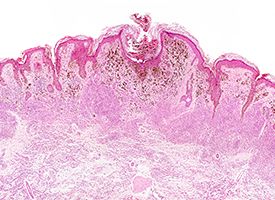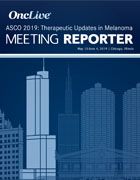Publication
Article
Special Issues
Second Relapse Common After Initial Melanoma Recurrence on Adjuvant PD-1 Inhibition
Author(s):
Despite local therapy, many patients with locoregional recurrence of melanoma during or after adjuvant anti–PD-1 therapy relapse again.

Despite local therapy, many patients with locoregional recurrence of melanoma during or after adjuvant anti—PD-1 therapy relapse again. Moreover, the benefit of second-line adjuvant treatment in this group of patients is unclear.
Patients with distant recurrence during or after adjuvant anti—PD-1 therapy are likely resistant to the checkpoint inhibitor treatment and require a change in therapy. Anti–PD-1 therapy may, however, be active in those with late distant recurrence, according to results presented by Carina Owen, MBBS, at the 2019 ASCO Annual Meeting.1
In a retrospective, multicenter analysis, investigators examined data from 136 patients with cutaneous stage III/IV resected melanoma who were managed at 16 international melanoma centers in Australia and who recurred having received a PD-1 inhibitor in the adjuvant setting.
The 136 patients are estimated to represent 17% of the total number of patients started on adjuvant anti—PD-1 therapy at these clinics.
“This is lower than the recurrence rate we observe at 1 year in the clinical trials because of a shorter follow-up in our cohort,” said Owen, a medical oncology fellow at the Melanoma Institute Australia, in Sydney, Australia.
In the analysis, three-fourths of patients received adjuvant treatment on a clinical trial, including some treated with the CTLA-4 inhibitor ipilimumab (Yervoy).
The median age was 57 years, and 50% had a BRAF V600 mutation. The American Joint Committee on Cancer 8th edition stage at treatment was IIIC in 49% of patients, IIIB in 31%, IV in 12%, IIID in 4%, and IIIA in 4% of patients.
The time to initial recurrence since starting adjuvant anti—PD-1 treatment was a median 4.6 months. Additionally, 71% recurred during adjuvant anti–PD-1 treatment and 29% had recurrence after stopping the checkpoint inhibitor. Ten percent of patients completed 12 months of treatment and then had a recurrence; 18% stopped earlier than 1 year due to unacceptable toxicity.
The pattern of initial recurrence was locoregional only in 43% of patients and distant in 57%.
“As the study went on, many of the patients with locoregional relapse later developed distant metastases, so at the end of the study, three-fourths had distant metastases,” said Owen.
Of the 48 patients with locoregional first recurrence, all were managed with resection of their relapse initially, and 11 also received second-line adjuvant systemic therapy in the form BRAF/MEK inhibition or anti—PD-1 therapy. At a median follow-up of 8.3 months, of the 48 patients with resectable locoregional recurrence, 56% have subsequently recurred, with 38% having distant metastases. Two deaths occurred.
Seventy-two patients who had an initial distant recurrence received systemic therapy. When considering these 72 patients, and the 11 patients who received adjuvant systemic therapy with locoregional recurrence who later developed distant recurrence (n = 83), the first-line systemic therapy choice was ipilimumab-based therapy in 42%, a BRAF/MEK inhibitor combination in 39%, anti—PD-1 monotherapy in 13%, and anti–PD-1 therapy plus a novel agent in 6% of patients. Most patients (86%) recurred on adjuvant anti–PD-1 therapy.
Of the patients who received immunotherapy at distant recurrence, 40% to 49% had stage IV M1a/b disease. In the group of patients who received targeted therapy, 32% had stage IV M1a/b disease “because there were more patients in that group with visceral metastases or brain metastases,” said Owen. “Also, the targeted therapy group had more patients with a raised lactate dehydrogenase (LDH).”
The first-line systemic therapy choice in the 47 patients with BRAF-mutant melanoma was targeted therapy in 68% and immunotherapy in 32%. In the 16 patients with BRAF-mutant M1c disease, the first choice was targeted therapy in 75% of these patients and immunotherapy in 25%. In the 10 patients with elevated levels of LDH, the first choice was targeted therapy in 90% and immunotherapy in 10% of patients.
Responses to first- and subsequent lines therapy were assessed in 92 evaluable patients. In those who recurred on adjuvant anti—PD-1 therapy, the objective response rate (ORR) was 24% with ipilimumab-based therapy (8/33 patients), 78% with BRAF/MEK inhibitor combination therapy (18/23), 11% with anti–PD-1 treatment plus a novel agent as part of a clinical trial (1/9), and 0% with continued anti–PD-1 monotherapy (0/6). Among those who recurred off of adjuvant anti–PD-1 treatment, the ORR to ipilimumab-based therapy was 40% (2/5 patients), 90% to BRAF/MEK inhibition (9/10), and 0% to anti–PD-1 therapy plus a novel agent (0/1).
In reviewing the entire group of 83 patients who received systemic therapy, 29% had subsequent progression and 20 (24%) patients died. At a median follow-up of 7.2 months, the median overall survival from first systemic therapy was 21.3 months.
Owen CN, Larkin JMG, Shoushtari AN, et al. A multicenter analysis of melanoma recurrence following adjuvant anti-PD1 therapy. J Clin Oncol. 2019;37(suppl; abstr 9502). meetinglibrary.asco.org/record/173458/slide.










